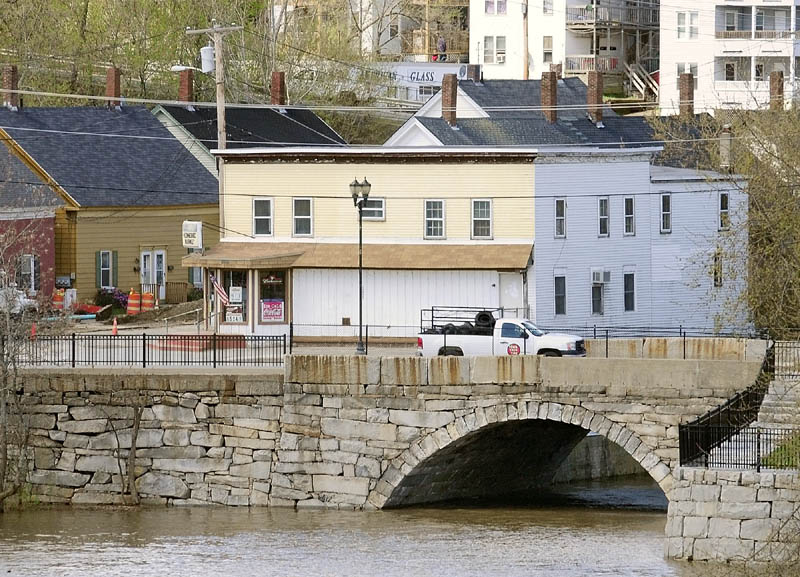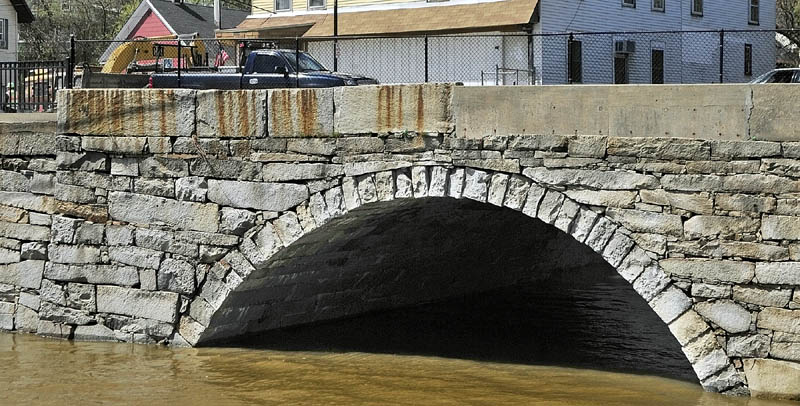AUGUSTA — In response to flooding and high water levels Monday, state officials nearly decided to close two key bridges over Bond Brook that carry thousands of vehicles each day.
That’s triggered concern among city officials about what sort of traffic mayhem could ensue if that happens and who should be responsible for dealing with it.
State Department of Transportation officials ultimately decided to monitor, but not close, the relatively small bridges over Bond Brook on Mount Vernon Avenue and Water Street. But officials said they could be closed in more severe conditions, out of concern that fast-moving water could scour and erode the lower structure of the bridges, compromise their integrity and cause them to fail.
City Manager William Bridgeo said until the recent discussion with state transportation officials, who told the city that the bridges could be closed when there’s high water, there had been no consideration of doing so. He expressed concern about the impact on traffic if the bridges on Water Street, which is Route 104, and Mount Vernon Avenue, which is routes 27, 11 and 8, were to be closed.
“That’s thousands and thousands of cars a day,” Bridgeo said. “The traffic complications that would ensue, I’d think, are significant. Some might say huge. It would be untenable for us to have a circumstance where those two major arteries could be closed for an indefinite period.”
The two bridges cross Bond Brook and are about a quarter mile from each other. Without them, traffic trying to get to north Augusta from points south would have to take Interstate 95 or Leighton Road. Or, if on the east side of the Kennebec River, drivers would have to go up Bangor Street to the third bridge, none of which are near the city’s downtown.
John Buxton, the state bridge maintenance engineer, said the two bridges are sensitive to high stream flows, so they were monitored closely during Monday’s heavy rainstorm. About 4.5 inches of rain fell in Augusta, according to the National Weather Service.
“It was kind of an extreme event, 4 inches of rain in such a short amount of time,” Buxton said. “Most of the nation’s bridges that fail, fail due to this (scouring by fast-moving water) phenomenon. As part of a national initiative we developed these scour plans for these type of bridges. It’s the right thing to do. It might seem a little conservative, to locals.”
Buxton said officials decided not to close the bridges after determining that one reason the water was so high was the tide, and the tide wasn’t adding to the speed of water flowing through the bridge. Bond Brook empties into the Kennebec River, which flows to the Atlantic, causing tidal changes.
He agreed that closing both bridges would be a major inconvenience for the city.
Augusta Public Works Director Lesley Jones said city and state officials plan to meet to discuss the traffic management plan in the event one or both of the bridges has to be closed.
She said if both were closed, “you’ve basically gridlocked traffic. You’d get into a pretty unpleasant situation pretty quickly, especially at rush hour.”
Bridgeo said city officials planned to have a conversation with state officials about who would be responsible for managing traffic when a bridge is closed.
If a bridge were closed, workers would put up signs and barricades and set up a detour route, according to Dale Doughty, director of maintenance and operations for the state transportation department. He said if municipalities where such bridges are located choose to supplement the signage by having local police direct traffic, they are welcomed to do so, but it’s on their own dime.
“If we close the bridge, we’d set up a detour, which would be able to stand on its own,” Doughty said. “We’d welcome the city of Augusta Police Department to augment that as they choose. It’s up to law enforcement to do what they deem is necessary. We want to work with them.”
Bridgeo, Buxton and Doughty all said the bridges are believed to be structurally safe. The Water Street bridge dates to the 1850s and Buxton said it’s the oldest bridge in the state’s inventory.
“We have no reason to believe they’re unsafe,” Bridgeo said. “I think the state is acting out of caution.”
After major storms, state transportation workers will take and record measurements at such bridges and, if no damage is apparent, the state will be less likely to close the bridge in similar conditions in the future, Buxton said.
Doughty said one reason the state monitors such old bridges closely is that environmental conditions have changed over the years. Today, more severe storms are occurring more frequently, and more development and other factors are causing water to move more quickly, and contain more erosive silt, he said.
“In addition to more severe climatic events, how those streams responded in 1964, compared to how they respond now, is very different,” Doughty said. “There is more silt, which has more erosive power. Our bridges are safe. We monitor them. This is just part of making sure.”
Keith Edwards — 621-5647
kedwards@centralmaine.com
Send questions/comments to the editors.






Success. Please wait for the page to reload. If the page does not reload within 5 seconds, please refresh the page.
Enter your email and password to access comments.
Hi, to comment on stories you must . This profile is in addition to your subscription and website login.
Already have a commenting profile? .
Invalid username/password.
Please check your email to confirm and complete your registration.
Only subscribers are eligible to post comments. Please subscribe or login first for digital access. Here’s why.
Use the form below to reset your password. When you've submitted your account email, we will send an email with a reset code.